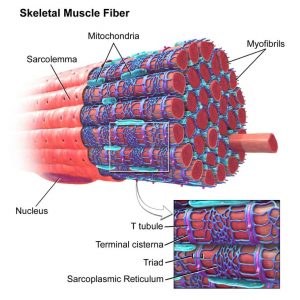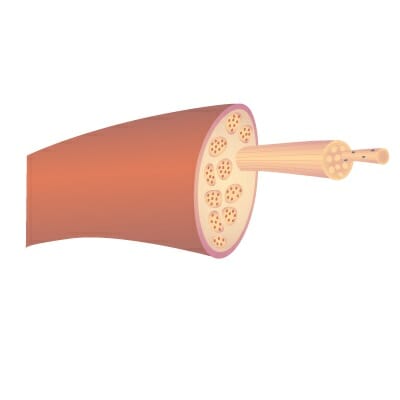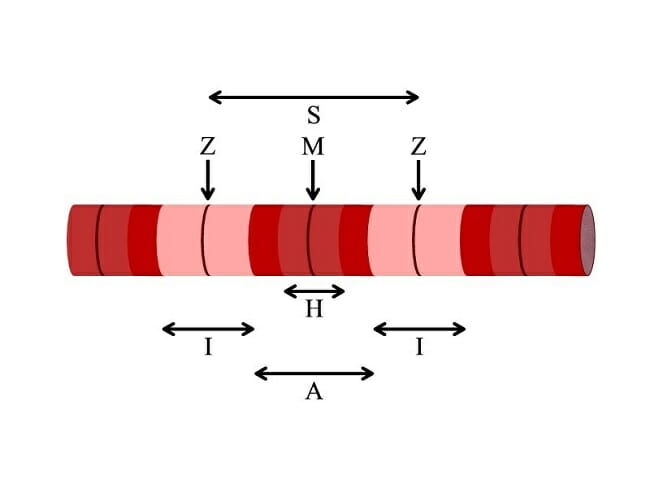Sarcomere definition
A sarcomere is the functional unit of striated muscle. This means it is the most basic unit that makes up our skeletal muscle. Skeletal muscle is the muscle type that initiates all of our voluntary movement. Herein lies the sarcomere’s main purpose. Sarcomeres are able to initiate large, sweeping movement by contracting in unison. Their unique structure allows these tiny units to coordinate our muscles’ contractions.

The image depicts skeletal muscle fiber.
In fact, the contractile properties of muscle are a defining characteristic of animals. Animal movement is notably smooth and complex. Dexterous movement requires a change in muscle length as the muscle flexes. This calls for a molecular structure that can shorten along with the shortening muscle. Such requisites are found in the sarcomere.
Upon closer inspection, skeletal muscle tissue gives off a striped appearance, called striation. These “stripes” are given off by a pattern of alternating light and dark bands corresponding to different protein filaments. These stripes are formed by the interlocking fibers that comprise each sarcomere. Tubular fibers called myofibrils are the basic components that form muscle tissue. However, myofibrils themselves are essentially polymers, or repeating units, of sarcomere. Myofibrils are fibrous and long, and made of two types of protein filament that stack on top of each other. Myosin is a thick fiber with a globular head, and actin is a thinner filament that interacts with myosin when we flex.

Depicted is a basic illustration of skeletal muscle’s underlying components, down to the sarcomere.
Sarcomere structure
When viewed under a microscope, muscle fibers of varied lengths are organized in a stacked pattern. The myofibril strands, thereby actin and myosin, form bundles of filament arranged parallel to one another. When a muscle in our body contracts, it is understood that the way this happens follows the sliding filament theory. This theory predicts that a muscle contracts when filaments are allowed to slide against each other. This interaction, then, is able to yield contractile force. However, the reason the sarcomere structure is so crucial in this theory is that a muscle needs to physically shorten. Thus, there is a need for a unit that is able to compensate for the lengthening or shortening of a flexing muscle.
The sliding filament theory was first posited by scientists who had used high-resolution microscopy and filament stains to observe myosin and actin filaments in action at various stages of contraction. They were able to visualize the physical lengthening of the sarcomere in its relaxed state, and the shortening in its contracted state. Their observations led to the discovery of sarcomere zones.

The figure depicts the structure of a Sarcomere. (Each zone is labeled).
They first observed that the dynamic changes that were taking place were always happening in the same spots, or zones. They noticed that one zone of repeated sarcomere, later called the “A band,” maintained a constant length during contraction. The A band has a higher content of thick myosin filament, as expected by the area’s rigidity. The A band is the area in the center of the sarcomere where thick and thin filaments overlap. This gave researchers an idea of myosin’s central location. Within the A band is the H zone, which is the area composed only of thick myosin. Essentially, the A band can be thought to include “all” of the myosin including the myosin intertwined with actin at its bulbous head. Located on each end of the sarcomere’s length is the I band. The I bands are the two regions that exclusively contain thin filament. A quick way to remember this is that the I band has “thIn, actIn” filaments. The thick filaments are located not too far from the site of the I band; but on either side, their margins delineate where the thick filaments end. Likewise, the Z lines or discs that give sarcomeres a striped appearance under a light microscope actually delineate the regions between adjacent sarcomeres. The M line, or middle division, is found right in the middle of the Z lines and contain a less important third filament called myomesin.
Filament mental shortcut:
- I is a thin letter, contains only thin filaments.
- H is a wider letter, contains only thick filaments.
As mentioned before, contraction happens when the thick filaments slide along the thin filaments in quick succession to shorten the myofibrils. However, a crucial distinction to remember is that the myofilaments themselves do not contract. It is the sliding action that lends them their power to shorten or lengthen.
Sarcomere function
Filament sliding generates muscle tension, which is without question the sarcomere’s main contribution. This action lends muscles their physical force. A quick analogy of this is the way a long ladder can be extended or folded depending on our needs for it, without physically shortening its metal parts.
Thankfully, recent research gives us a good idea of how this sliding works. The sliding filament theory has been modified to include how myosin is able to pull on actin to shorten the length of the sarcomere. In this theory, myosin’s globular head is located close to actin in an area called the S1 region. This region is rich in hinged segments that can bend and thus facilitate contraction. The bending of S1 may be the key to understanding how myosin is able to “walk” along the length of the actin filaments. This is accomplished by myosin-actin cycling. This is the binding of the myosin S1 fragment, its contraction, and its eventual release.
When myosin and actin bind, they form extensions called “cross-bridges.” These cross-bridges can form and break with the presence (or absence) of ATP. ATP makes S1 contraction possible. When ATP binds to actin filament, it moves it into a position that exposes its myosin binding site. This allows myosin’s globular head to bind to this site to form the cross-bridge. This binding causes the phosphate group of the ATP to dissociate, and thus myosin initiates its power stroke. Myosin thus enters a lower energy state where the sarcomere can shorten. Moreover, ATP must bind myosin to break the cross-bridge, and allow myosin to re-bind actin and initiate the next spasm.
Quiz
1. Which zone of the sarcomere maintains a constant length during contraction?
A. Z lines
B. A band
C. I band
D. S zone
2. Which of the following contains only actin filament?
A. A band
B. H band
C. I band
D. Z line
3. Which of the following contains only myosin filament?
A. A band
B. H band
C. I band
D. Z line
References
- Krans, Jacob et al. (2010). “The sliding filament theory of muscle contraction.” Nature Education 3. 3(9):66.
- MH Education (2017). “Animation: Sarcomere Contraction.” Human Anatomy: Mckinley O’Loughlin.” Retrieved on 2017-6-16 from http://www.macroevolution.net/sarcomere.html
- Boundless (2017). “ATP and muscle contraction.” Boundless: The Musculoskeletal System. Retrieved on 2017-6-15 from https://www.boundless.com/biology/textbooks/boundless-biology-textbook/the-musculoskeletal-system-38/muscle-contraction-and-locomotion-218/atp-and-muscle-contraction-826-12069/
